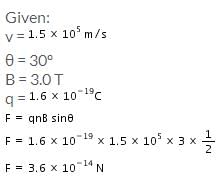All Exams >
NEET >
NCERT on your Fingertips 2025-2026 Edition >
All Questions
All questions of MCQ Corner for NEET Exam
If we double the radius of a current carrying coil keeping the current unchanged. what happens to the magnetic field at its Centre?- a)halved
- b)doubled
- c)remains unchanged
- d)becomes four times
Correct answer is option 'A'. Can you explain this answer?
If we double the radius of a current carrying coil keeping the current unchanged. what happens to the magnetic field at its Centre?
a)
halved
b)
doubled
c)
remains unchanged
d)
becomes four times

|
Ciel Knowledge answered |
As,
B=μonI/2a
a ->radius
B ∝1/a
B1/B2=a2/a1
B1=2B2
B2=(1/2) x B1,
Magnetic field is halved.
B=μonI/2a
a ->radius
B ∝1/a
B1/B2=a2/a1
B1=2B2
B2=(1/2) x B1,
Magnetic field is halved.
Two thin long parallel wires separated by a distance b are carrying a current i ampere each. The magnitude of the force per unit length exerted by one wire on the other is- a)

- b)

- c)

- d)

Correct answer is option 'D'. Can you explain this answer?
Two thin long parallel wires separated by a distance b are carrying a current i ampere each. The magnitude of the force per unit length exerted by one wire on the other is
a)
b)
c)
d)

|
EduRev Humanities answered |
Given, i1=i2=i
∴F=μ0i2l/2πb
Hence, force per unit length is F=μ0i2/2πb
∴F=μ0i2l/2πb
Hence, force per unit length is F=μ0i2/2πb
An electron with a speed of 1.8 x 106 m/s is moving in a circular orbit in a uniform magnetic field of 10-4 Wb/m², the radius of the circular path of the electron is
- a)10.63 m
- b)1.063 m
- c)106.3 m
- d)0.1063 m
Correct answer is option 'D'. Can you explain this answer?
An electron with a speed of 1.8 x 106 m/s is moving in a circular orbit in a uniform magnetic field of 10-4 Wb/m², the radius of the circular path of the electron is
a)
10.63 m
b)
1.063 m
c)
106.3 m
d)
0.1063 m

|
Learners Habitat answered |
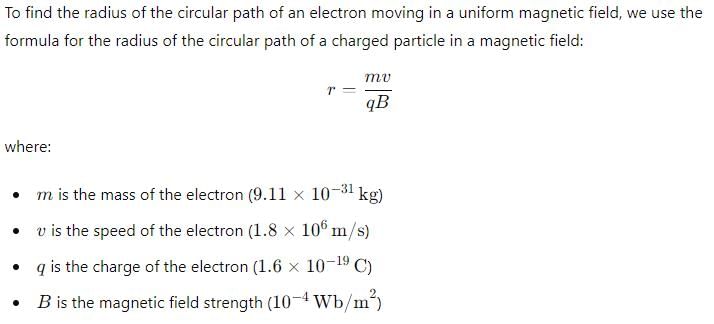
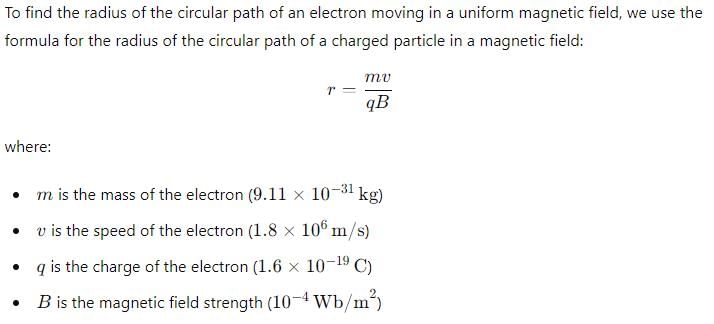
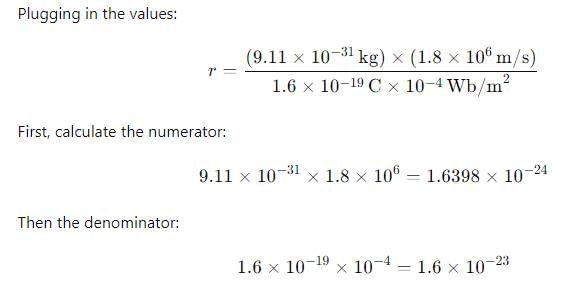
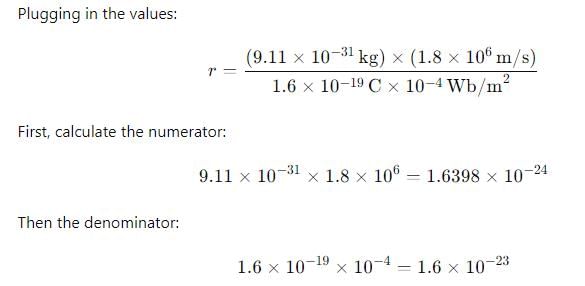
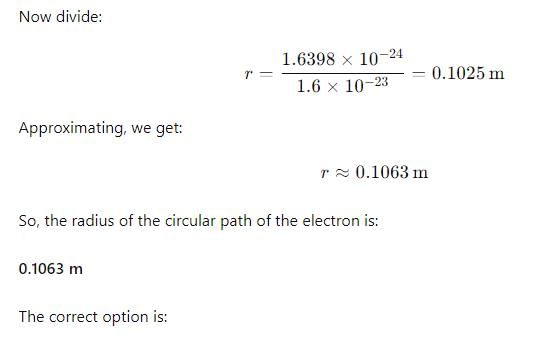
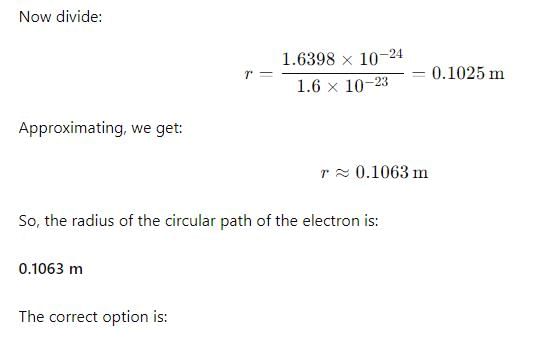
4. 0.1063 m
An electron and proton enter a magnetic field with equal velocities. Which one of them experiences a greater force?- a)electron
- b)proton
- c)Both experience same magnitude of force
- d)No prediction can be made.
Correct answer is option 'C'. Can you explain this answer?
An electron and proton enter a magnetic field with equal velocities. Which one of them experiences a greater force?
a)
electron
b)
proton
c)
Both experience same magnitude of force
d)
No prediction can be made.

|
Divey Sethi answered |
As charges and velocities are same
F=q(V×B)
So having the same magnitude of charge and same velocity, they'll experience the same magnitude of force.
F=q(V×B)
So having the same magnitude of charge and same velocity, they'll experience the same magnitude of force.
Two concentric coils carry the same current in opposite directions. The diameter of the inner coil is half that of the outer coil. If the magnetic field produced by the outer coil at the common centre are 1 T, the net field at the centre is
- a)4T
- b)2T
- c)1T
- d)3T
Correct answer is option 'C'. Can you explain this answer?
Two concentric coils carry the same current in opposite directions. The diameter of the inner coil is half that of the outer coil. If the magnetic field produced by the outer coil at the common centre are 1 T, the net field at the centre is
a)
4T
b)
2T
c)
1T
d)
3T
|
|
Krishna Iyer answered |
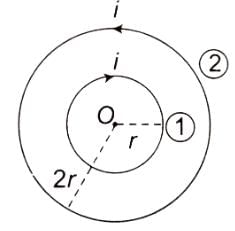
The magnetic field produced by a current-carrying coil at its center is given by the formula,
B = μ0 * (N*I/R),
where,
B is the magnetic field,
μ0 is the permeability of free space,
N is the number of turns in the coil,
I is the current through the coil, and
R is the radius of the coil.
In this case, both the coils carry the same current but in opposite directions. So, the fields produced by them will be in opposite directions. Also, the diameter of the inner coil is half that of the outer coil. Thus, the radius of the inner coil will be half that of the outer coil.
Therefore, the field at the center due to the inner coil will be double that due to the outer coil (because the magnetic field is inversely proportional to the radius).
Since the fields are in opposite directions, the net field at the center will be the difference between the two fields. That is, 2B (due to the inner coil) - B (due to the outer coil) = B.
So, if the field due to the outer coil is 1 T (Tesla), the net field at the center will also be 1 T.
Hence, the correct answer is 3. 1T.
The magnetic field due to circular coil of 200 turns of diameter 0.1m carrying a current of 5A at a point on the axis of the coil at a distance 0.15m from the center of the coil will be- a)

- b)

- c)

- d)

Correct answer is option 'D'. Can you explain this answer?
The magnetic field due to circular coil of 200 turns of diameter 0.1m carrying a current of 5A at a point on the axis of the coil at a distance 0.15m from the center of the coil will be
a)
b)
c)
d)
|
|
Krishna Iyer answered |
B=μ02πnIa2/4π (a2+x2)3/2
=10−7×2×(22/7)×200×5×(0⋅1/2)2/ [(0⋅1/2)2+(0⋅15)2]3/2
=39.74x10-5
=10−7×2×(22/7)×200×5×(0⋅1/2)2/ [(0⋅1/2)2+(0⋅15)2]3/2
=39.74x10-5
A proton with 1MeV kinetic energy is moving in a circular path of radius R in a uniform magnetic field. What should be the energy of an α – particle to describe a circle of same radius in the same magnetic field?- a)2 MeV
- b)0.5 MeV
- c)1 MeV
- d)4 MeV
Correct answer is option 'C'. Can you explain this answer?
A proton with 1MeV kinetic energy is moving in a circular path of radius R in a uniform magnetic field. What should be the energy of an α – particle to describe a circle of same radius in the same magnetic field?
a)
2 MeV
b)
0.5 MeV
c)
1 MeV
d)
4 MeV

|
Shraddha Singh answered |
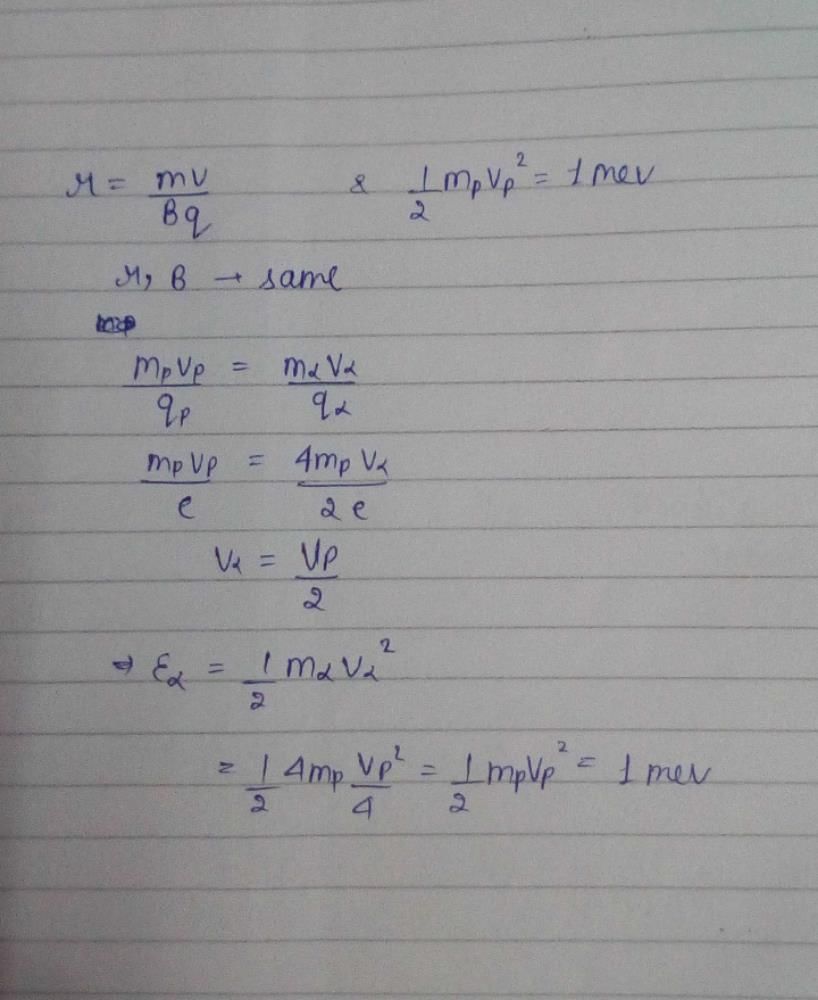
Wire of length l, carries a steady current I. It is bent first to form a circular coil of one turn. The same wire of same length is now bent more sharply to give two loops of smaller radius the magnetic field at the centre caused by the same current is- a)one third of its initial value
- b)nine times of its initial value
- c)four times of its initial value
- d)unaltered
Correct answer is option 'C'. Can you explain this answer?
Wire of length l, carries a steady current I. It is bent first to form a circular coil of one turn. The same wire of same length is now bent more sharply to give two loops of smaller radius the magnetic field at the centre caused by the same current is
a)
one third of its initial value
b)
nine times of its initial value
c)
four times of its initial value
d)
unaltered
|
|
Om Desai answered |
Let the radii be r1 and r2 respectively.
Since there are two turns of radius r2, r1=2r2
Magnetic field B at the centre of the coil of radius r1 B1=μoi/2r1=μoi/4r2
Magnetic field B at the center of the coil of radius r2 B2=2×μoi/2r2
∴ B2/B1 =(2× μoi/2r2)/(μoi /4r2) =4
Hence the answer is option C, four times its initial value.
Since there are two turns of radius r2, r1=2r2
Magnetic field B at the centre of the coil of radius r1 B1=μoi/2r1=μoi/4r2
Magnetic field B at the center of the coil of radius r2 B2=2×μoi/2r2
∴ B2/B1 =(2× μoi/2r2)/(μoi /4r2) =4
Hence the answer is option C, four times its initial value.
The frequency (v) of charged particle, moving at right angles to the magnetic field is independent of- a)radius of circular trajectory (r)
- b)magnetic induction (B)
- c)speed of the particle (v)
- d)both speed of the particle (v) and radius of trajectory (r).
Correct answer is option 'D'. Can you explain this answer?
The frequency (v) of charged particle, moving at right angles to the magnetic field is independent of
a)
radius of circular trajectory (r)
b)
magnetic induction (B)
c)
speed of the particle (v)
d)
both speed of the particle (v) and radius of trajectory (r).

|
Infinity Academy answered |
Frequency (v) = qB/2πm.
Frequency is independent of radius of trajectory of particle and speed of particle.
Frequency is independent of radius of trajectory of particle and speed of particle.
A 2 cm long copper wire having mass of 6 gm, dips in to two mercury pools to form a complete circuit. The wire is placed between the poles of a magnet which causes a field strength of 0.3 T. Find the initial upward acceleration of copper wire after 100 A of current is passed through the wire (g = 10 m/s2)- a)1 m/s2
- b)10 m/s2
- c)100 m/s2
- d)90 m/s2
Correct answer is option 'D'. Can you explain this answer?
A 2 cm long copper wire having mass of 6 gm, dips in to two mercury pools to form a complete circuit. The wire is placed between the poles of a magnet which causes a field strength of 0.3 T. Find the initial upward acceleration of copper wire after 100 A of current is passed through the wire (g = 10 m/s2)
a)
1 m/s2
b)
10 m/s2
c)
100 m/s2
d)
90 m/s2
|
|
Hansa Sharma answered |
ma=Bil−mg
a=0.3×100×2×10−2−10×6×10−3/ m
a= 0.6−0.06/6×10−3
=100−10
=90ms−2
a=0.3×100×2×10−2−10×6×10−3/ m
a= 0.6−0.06/6×10−3
=100−10
=90ms−2
A particle of charge 1.6 x 10-19 C and mass 1.8 x 10-27 kg is moving around the path of radius 2 x 104 m with velocity 2.4 x 106 m/s. The magnetic field necessary is (in Wb/m²)- a)13.5 x 10-6
- b)135 x 10-6
- c)0.135 x 10
- d)1.35 x 10-6
Correct answer is option 'D'. Can you explain this answer?
A particle of charge 1.6 x 10-19 C and mass 1.8 x 10-27 kg is moving around the path of radius 2 x 104 m with velocity 2.4 x 106 m/s. The magnetic field necessary is (in Wb/m²)
a)
13.5 x 10-6
b)
135 x 10-6
c)
0.135 x 10
d)
1.35 x 10-6
|
|
Sreemoyee Choudhury answered |
Explanation:
When an electron is projected in a uniform electric field and a uniform magnetic field, both pointing in the same direction as the electron's velocity, the following happens:
1. Electric field:
The electric field exerts a force on the electron in the direction of the field. Since the electron is negatively charged, it experiences a force opposite to the direction of the electric field. Therefore, the electric field does not affect the direction of the electron's motion.
2. Magnetic field:
The magnetic field exerts a force on the electron perpendicular to both the field direction and the electron's velocity. The force is given by the Lorentz force equation:
F = q(v x B)
where F is the force, q is the charge of the electron, v is its velocity, and B is the magnetic field.
In this case, the force is directed inward, towards the center of the circular path. The magnitude of the force is given by:
|F| = qvB
where |F| is the magnitude of the force.
Since the force is perpendicular to the velocity, it causes the electron to move in a circular path around the magnetic field lines. The radius of the path is given by:
r = mv/qB
where r is the radius of the path, m is the mass of the electron, and v is its velocity.
3. Combined effect:
Since the electric field does not affect the direction of the electron's motion, the only effect is due to the magnetic field. As the electron moves in a circular path, it loses kinetic energy due to the work done by the magnetic force. Therefore, its velocity decreases in magnitude.
Hence, the correct option is D- The electron velocity will decrease in magnitude.
When an electron is projected in a uniform electric field and a uniform magnetic field, both pointing in the same direction as the electron's velocity, the following happens:
1. Electric field:
The electric field exerts a force on the electron in the direction of the field. Since the electron is negatively charged, it experiences a force opposite to the direction of the electric field. Therefore, the electric field does not affect the direction of the electron's motion.
2. Magnetic field:
The magnetic field exerts a force on the electron perpendicular to both the field direction and the electron's velocity. The force is given by the Lorentz force equation:
F = q(v x B)
where F is the force, q is the charge of the electron, v is its velocity, and B is the magnetic field.
In this case, the force is directed inward, towards the center of the circular path. The magnitude of the force is given by:
|F| = qvB
where |F| is the magnitude of the force.
Since the force is perpendicular to the velocity, it causes the electron to move in a circular path around the magnetic field lines. The radius of the path is given by:
r = mv/qB
where r is the radius of the path, m is the mass of the electron, and v is its velocity.
3. Combined effect:
Since the electric field does not affect the direction of the electron's motion, the only effect is due to the magnetic field. As the electron moves in a circular path, it loses kinetic energy due to the work done by the magnetic force. Therefore, its velocity decreases in magnitude.
Hence, the correct option is D- The electron velocity will decrease in magnitude.
A circular coil of radius r carries current I. The magnetic field at its center is B. at what distance from the center on the axis of the coil magnetic field will be B/8- a)√3R
- b)√2R
- c)2R
- d)3R
Correct answer is option 'A'. Can you explain this answer?
A circular coil of radius r carries current I. The magnetic field at its center is B. at what distance from the center on the axis of the coil magnetic field will be B/8
a)
√3R
b)
√2R
c)
2R
d)
3R

|
Shilpa Saha answered |
As you know that magnetic field at point on the axis of current carrying ring is


where x is the point on the axis of ring, R is the radius of ring , i is the current carrying on ring and N is the number of turns .
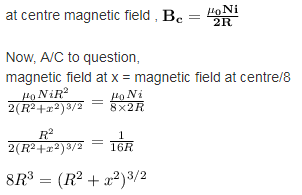
This is possible only when x = +-√3R
Hence, √3R distance from the centre magnetic field is equal to magnetic field at centre .
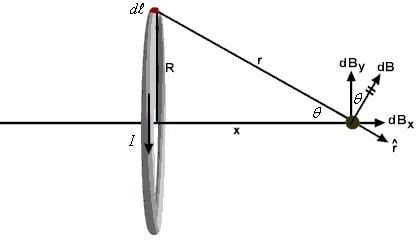

A charged particle is moving on circular path with velocity v in a uniform magnetic field B, if the velocity of the charged particle is doubled and strength of Magnetic field is halved, then radius becomes- a)8 times
- b)4 times
- c)2 times
- d)16 times
Correct answer is option 'B'. Can you explain this answer?
A charged particle is moving on circular path with velocity v in a uniform magnetic field B, if the velocity of the charged particle is doubled and strength of Magnetic field is halved, then radius becomes
a)
8 times
b)
4 times
c)
2 times
d)
16 times
|
|
Meera Singh answered |
As 
According to the question, v‘ = 2v and B' = B/2
∴

According to the question, v‘ = 2v and B' = B/2
∴

The force acting on a charge q moving with velocity in a magnetic field
in a magnetic field is given by
is given by- a)

- b)

- c)

- d)

Correct answer is option 'C'. Can you explain this answer?
The force acting on a charge q moving with velocity in a magnetic field
in a magnetic field is given by
is given by
a)
b)
c)
d)
|
|
Neha Sharma answered |
The magnetic force on a free moving charge is perpendicular to both the velocity of the charge and the magnetic field with direction given by the right hand rule . The force is given by the charge times the vector product of velocity and magnetic field.
A Charge is fired through a magnetic field. The magnetic force acting on it is maximum when the angle between the direction of motion and magnetic field is- a)π
- b)zero
- c)π/2
- d)π/4
Correct answer is option 'C'. Can you explain this answer?
A Charge is fired through a magnetic field. The magnetic force acting on it is maximum when the angle between the direction of motion and magnetic field is
a)
π
b)
zero
c)
π/2
d)
π/4
|
|
Krishna Iyer answered |
The force will have a magnitude F=qvB sin q, thus it will be maximum if sin q is maximum. Thus, angle between velocity and magnetic field should be 90o or the charge particle moves perpendicular to the velocity vector.
A rectangular loop carrying a current I is situated near a long straight wire such that the wire is parallel to the one of the sides of the loop and is in a plane of the loop. If a steady current I is established in wire as shown in figure, the loop will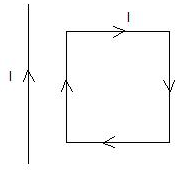
- a)move away from the wire or towards right
- b)remain stationary
- c)rotate about an axis parallel to the wire
- d)move towards the wire
Correct answer is option 'D'. Can you explain this answer?
A rectangular loop carrying a current I is situated near a long straight wire such that the wire is parallel to the one of the sides of the loop and is in a plane of the loop. If a steady current I is established in wire as shown in figure, the loop will
a)
move away from the wire or towards right
b)
remain stationary
c)
rotate about an axis parallel to the wire
d)
move towards the wire

|
Top Rankers answered |
The long straight wire and side AB carry current in the same direction, hence will attract each other.
The long straight wire and side CD carry current in the opposite direction, hence will repel each other.
Force on side BC will be equal and opposite to force on side DA.
Since CD is farther from the wire than AB, the force of attraction on AB will exceed the force of repulsion on CD.
Hence, there will be a net force of attraction on the loop ABCD and it will move towards the wire.
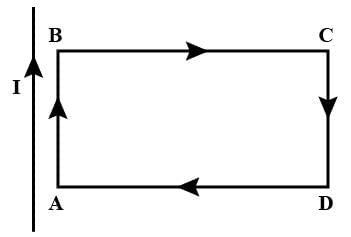
The long straight wire and side CD carry current in the opposite direction, hence will repel each other.
Force on side BC will be equal and opposite to force on side DA.
Since CD is farther from the wire than AB, the force of attraction on AB will exceed the force of repulsion on CD.
Hence, there will be a net force of attraction on the loop ABCD and it will move towards the wire.

The force between two current carrying conductors is due to which of the following- a)Magnetic effect of electric current
- b)Electrostatic interaction
- c)Electromagnetic induction
- d)Polarisation
Correct answer is option 'A'. Can you explain this answer?
The force between two current carrying conductors is due to which of the following
a)
Magnetic effect of electric current
b)
Electrostatic interaction
c)
Electromagnetic induction
d)
Polarisation

|
Virat answered |
Current carring wire produce magnetic field
Which of the following laws give the direction of induced e.m.f- a)Faraday’s Law
- b)Ampere’s Theorem
- c)Biot Savart Law
- d)Lenz’s Law
Correct answer is option 'D'. Can you explain this answer?
Which of the following laws give the direction of induced e.m.f
a)
Faraday’s Law
b)
Ampere’s Theorem
c)
Biot Savart Law
d)
Lenz’s Law

|
Knowledge Hub answered |
Lenz’s law is used for determining the direction of induced current.
Lenz’s law of electromagnetic induction states that the direction of induced current in a given magnetic field is such that it opposes the induced change by changing the magnetic field.
Following is the formula of Lenz’s law:
ϵ=−N (∂ϕB/∂t)
Where,
- ε is the induced emf
- ∂ΦB is the change in magnetic flux
- N is the number of turns in the coil
Lenz’s law finds application in electromagnetic braking and in electric generators
A straight conductor carrying current I is split into circular loop as shown in figure a , the magnetic induction at the center of the circular loop is
- a)Zero
- b)

- c)

- d)Infinite
Correct answer is option 'A'. Can you explain this answer?
A straight conductor carrying current I is split into circular loop as shown in figure a , the magnetic induction at the center of the circular loop is
a)
Zero
b)
c)
d)
Infinite
|
|
Jayant Mishra answered |
The magnetic field at the center O due to the upper side of the semicircular current loop is equal and opposite to that due to the lower side of the loop.
In a current carrying conductor varying electric field generates- a)Magnetic field
- b)Potential gradient
- c)Resistance
- d)Current
Correct answer is option 'A'. Can you explain this answer?
In a current carrying conductor varying electric field generates
a)
Magnetic field
b)
Potential gradient
c)
Resistance
d)
Current
|
|
Animesh Nhagal answered |
Moving electrons in conducter produce electromagnetic wave...
When a charged particle moves in a magnetic field, its kinetic energy always- a)remain constant
- b)first increases then decreases.
- c)decreases
- d)increases
Correct answer is option 'A'. Can you explain this answer?
When a charged particle moves in a magnetic field, its kinetic energy always
a)
remain constant
b)
first increases then decreases.
c)
decreases
d)
increases
|
|
Rajeev Saxena answered |
The magnetic field does no work, so the kinetic energy and speed of a charged particle in a magnetic field remain constant. The magnetic force, acting perpendicular to the velocity of the particle, will cause circular motion.
A solenoid coil of 300 turns /m is carrying a current of 5 A. Calculate the magnitude of magnetic intensity inside the solenoid.- a)1.9 T
- b)1.9 X 10-6 T
- c)1.9 X 10-3 T
- d)1.9 X 10-7 T
Correct answer is option 'C'. Can you explain this answer?
A solenoid coil of 300 turns /m is carrying a current of 5 A. Calculate the magnitude of magnetic intensity inside the solenoid.
a)
1.9 T
b)
1.9 X 10-6 T
c)
1.9 X 10-3 T
d)
1.9 X 10-7 T
|
|
Jyoti Sengupta answered |
We know, Magnetic field of solenoid,
= μonI
=4πx10-7x300x5
=4πx15x10-5
=6πx10-9
=18.89x10-9
≈1.9x10-3T
= μonI
=4πx10-7x300x5
=4πx15x10-5
=6πx10-9
=18.89x10-9
≈1.9x10-3T
Along an infinitely long conductor carrying a current of 8 A we keep another conductor of length 5 m carrying a current of 3 A. Both the conductors are 10 cm apart. Find the force on small conductor.- a)2.4 X 10-4 N
- b)9.6 X 10-4 N
- c)2.6 X 10-6 N
- d)9.6 X 10-5 N
Correct answer is option 'A'. Can you explain this answer?
Along an infinitely long conductor carrying a current of 8 A we keep another conductor of length 5 m carrying a current of 3 A. Both the conductors are 10 cm apart. Find the force on small conductor.
a)
2.4 X 10-4 N
b)
9.6 X 10-4 N
c)
2.6 X 10-6 N
d)
9.6 X 10-5 N
|
|
Shreya Singh answered |
F=4π×10^-7 i1 i2 l/2π rF= 4π × 10^-7×8×3× 5./2π×10^-2.F= 2×10^-7×8×3× 5 ×100.F=2.4×10^-4.
Two straight horizontal parallel wires are carrying the same current in same direction, d is the distnace between the wires. You are povided with a small freely suspended magnetic needle. At which of the following positions will the orientation of the needle be independent of the magnitude of current in the wires?- a)At a distance d/2 from any of the wires.
- b)At a distance d/2 from any of the wires in the horizontal plane.
- c)Anywhere on the circumference of a vertical circle of radius d ans centre half way between the wires.
- d)At points half way between the wires in the horizontal plane.
Correct answer is option 'A'. Can you explain this answer?
Two straight horizontal parallel wires are carrying the same current in same direction, d is the distnace between the wires. You are povided with a small freely suspended magnetic needle. At which of the following positions will the orientation of the needle be independent of the magnitude of current in the wires?
a)
At a distance d/2 from any of the wires.
b)
At a distance d/2 from any of the wires in the horizontal plane.
c)
Anywhere on the circumference of a vertical circle of radius d ans centre half way between the wires.
d)
At points half way between the wires in the horizontal plane.
|
|
Nandini Patel answered |
The answer is d.
At these points, the resultant field =0
At these points, the resultant field =0
A circular loop of radius 0.0157 m carries a current of 2 A. The magnetic field at the centre of the loop is- a)3.14 x 10-5 weber /m2
- b)1.57 x 10-5 weber /m2
- c)1.57 x 10-5 weber /m2
- d)8.0 x 10-5 weber /m2
Correct answer is option 'D'. Can you explain this answer?
A circular loop of radius 0.0157 m carries a current of 2 A. The magnetic field at the centre of the loop is
a)
3.14 x 10-5 weber /m2
b)
1.57 x 10-5 weber /m2
c)
1.57 x 10-5 weber /m2
d)
8.0 x 10-5 weber /m2
|
|
Hansa Sharma answered |
The magnetic field due to a circular loop is given by:
B= μ02πi/4πr
=10−7×2π×2/0.0157
=8×10−5 Wb/m2
B= μ02πi/4πr
=10−7×2π×2/0.0157
=8×10−5 Wb/m2
The magnetic field inside a toroid of radius R is B. If the current through it is doubled and the radius increased four times keeping the number of turns per unit length same, then the magnetic field produced by it will be- a)B
- b)2B
- c)4B
- d)B/2
Correct answer is option 'B'. Can you explain this answer?
The magnetic field inside a toroid of radius R is B. If the current through it is doubled and the radius increased four times keeping the number of turns per unit length same, then the magnetic field produced by it will be
a)
B
b)
2B
c)
4B
d)
B/2
|
|
Nandini Iyer answered |
In the 1st case,
B1= μ0Ni/2πr
In the 2nd case,
B2= μ0N2i/2π4r
Comparing both of them,
μ0Ni/2πr=μ0N2i/2π4r
B1=B2/2
B2=2B1
B1= μ0Ni/2πr
In the 2nd case,
B2= μ0N2i/2π4r
Comparing both of them,
μ0Ni/2πr=μ0N2i/2π4r
B1=B2/2
B2=2B1
The constant μo is called- a)Absolute Permeability
- b)Coefficient of mutual induction
- c)Coefficient of self induction
- d)Relative permeability
Correct answer is option 'A'. Can you explain this answer?
The constant μ
o
is calleda)
Absolute Permeability
b)
Coefficient of mutual induction
c)
Coefficient of self induction
d)
Relative permeability
|
|
Harsh Singhal answered |
B&c direct wrong
now for d relative permeability is Ur/U0
now for d relative permeability is Ur/U0
The connecting wires of a battery of an automobile carry 200 A of current. Calculate the force per unit length between the wires if they are 50 cm long and 2 cm apart?- a)4Nm-1
- b)0.4Nm-1
- c)0.04Nm-1
- d)40Nm-1
Correct answer is option 'B'. Can you explain this answer?
The connecting wires of a battery of an automobile carry 200 A of current. Calculate the force per unit length between the wires if they are 50 cm long and 2 cm apart?
a)
4Nm-1
b)
0.4Nm-1
c)
0.04Nm-1
d)
40Nm-1
|
|
Naina Bansal answered |
Current in both wires, I = 200 A
Distance between the wires, r = 2 cm = 0.02 m
Length of the two wires, l = 50 cm = 0.5 m
Force between the two wires is given by the relation,

where, μo = permeability of free space = 4π x 10^-7 TmA^-1
So, F = [4π x 10^-7 x (200^2)]/[2π x 0.02]
=> F = 0.4 Nm^-1
In two current carrying conductors parallel currents________, anti parallel currents_________ .- a)attract , attract
- b)attract , repel
- c)repel , attract
- d)repel , repel
Correct answer is option 'B'. Can you explain this answer?
In two current carrying conductors parallel currents________, anti parallel currents_________ .
a)
attract , attract
b)
attract , repel
c)
repel , attract
d)
repel , repel
|
|
Pooja Mehta answered |
Two current carrying straight conductors placed near each other will exert (magnetic) forces on each other due to magnetic field of each other. ... Note − Parallel current carrying wires attract, and anti-parallel current carrying wires repel each other.
A long wire carrying a certain current produces a magnetic field of 0.8 Tesla at a distance 0.5 cm. Then magnetic field at a distance of 1 cm is:- a)0.16 Tesla
- b)0.2 Tesla
- c)0.8 Tesla
- d)0.4 Tesla
Correct answer is option 'D'. Can you explain this answer?
A long wire carrying a certain current produces a magnetic field of 0.8 Tesla at a distance 0.5 cm. Then magnetic field at a distance of 1 cm is:
a)
0.16 Tesla
b)
0.2 Tesla
c)
0.8 Tesla
d)
0.4 Tesla

|
Ambition Institute answered |
Ampere's Circuital Law:
- It gives the relationship between the current and the magnetic field created by it.
- This law says that the integral of magnetic field density (B) along an imaginary closed path is equal to the product of current enclosed by the path and permeability of the medium.
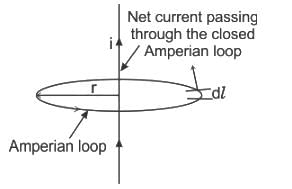

Where B = magnetic field, μ0 = permeability of free space and I = current passing through the coil
Given:
B1 = 0.8 T, d1 = 0.5 cm
The intensity of the magnetic field due to wire of infinite length at a distance d from it is given by

Where μ0 = permeability of free space, I = current in a wire, d = distance
As current is constant in the wire, then the magnetic field varies with the distance 'd' as
B∝1 / d
⇒ B1d1 = B2d2

= 0.4 T
A long straight wire in the horizontal plane carries a current of 75 A in north to south direction, magnitude and direction of field B at a point 3 m east of the wire is- a)4 x 10-6 T, vertical up
- b)5 x 10-6 T, vertical down
- c)5 x 10-6 T, vertical up
- d)4 x 10-6 T, vertical down
Correct answer is option 'C'. Can you explain this answer?
A long straight wire in the horizontal plane carries a current of 75 A in north to south direction, magnitude and direction of field B at a point 3 m east of the wire is
a)
4 x 10-6 T, vertical up
b)
5 x 10-6 T, vertical down
c)
5 x 10-6 T, vertical up
d)
4 x 10-6 T, vertical down
|
|
Anjali Sharma answered |
From Ampere circuital law
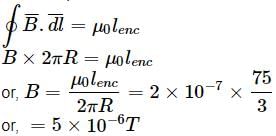
The direction of field at the given point will be vertical up determined by the screw rule or right hand rule.

The direction of field at the given point will be vertical up determined by the screw rule or right hand rule.
Convert the following sentences into simple past passive.
They never sent me the bill.Correct answer is 'I was never sent the bill'. Can you explain this answer?
Convert the following sentences into simple past passive.
They never sent me the bill.
They never sent me the bill.
|
|
Disha Saha answered |
When we convert an active sentence in the simple past tense into the passive voice, we use the verb 'was/were + past participle'. 'Was' is used when the subject is a singular noun or pronoun.
So the answer is, 'I was never sent the bill'.
So the answer is, 'I was never sent the bill'.
Two particles of equal charges after being accelerated through the same potential difference enter in a uniform transverse magnetic field and describe circular paths of radii R1 and R2. Then the ratio of their respective masses (M1/M2) is - a)R1/R2
- b)(R1/R2)2
- c)R2/R1
- d)(R2/R1)2
Correct answer is option 'B'. Can you explain this answer?
Two particles of equal charges after being accelerated through the same potential difference enter in a uniform transverse magnetic field and describe circular paths of radii R1 and R2. Then the ratio of their respective masses (M1/M2) is
a)
R1/R2
b)
(R1/R2)2
c)
R2/R1
d)
(R2/R1)2
|
|
Gaurav Kumar answered |

And Bqv = Mv2/R Or
 Using (i)
Using (i)or

∴ M ∝ R2 (∵ B, q and V are same for the given two particles)
Hence (M1/M2) = (R1/R2)2
Two α-partides have the ratio of their velocities as 3 : 2 on entering the field. If they move in different circular paths, then the ratio of the radii of their paths is- a)2 : 3
- b)3 : 2
- c)9 : 4
- d)4 : 9
Correct answer is option 'B'. Can you explain this answer?
Two α-partides have the ratio of their velocities as 3 : 2 on entering the field. If they move in different circular paths, then the ratio of the radii of their paths is
a)
2 : 3
b)
3 : 2
c)
9 : 4
d)
4 : 9
|
|
Amar Dasgupta answered |
Explanation:
Given:
Two α-particles have the ratio of their velocities as 3 : 2 on entering the field.
Let:
Let the velocities of the two α-particles be 3v and 2v respectively.
Let the radii of their circular paths be r1 and r2 respectively.
Velocity-radius relationship:
The ratio of the velocities is equal to the inverse ratio of the radii of circular paths.
Therefore, 3v/2v = r2/r1
=> r2/r1 = 3/2
=> r1/r2 = 2/3
Conclusion:
The ratio of the radii of their circular paths is 2 : 3.
Therefore, the correct answer is option 'b) 3 : 2'.
Given:
Two α-particles have the ratio of their velocities as 3 : 2 on entering the field.
Let:
Let the velocities of the two α-particles be 3v and 2v respectively.
Let the radii of their circular paths be r1 and r2 respectively.
Velocity-radius relationship:
The ratio of the velocities is equal to the inverse ratio of the radii of circular paths.
Therefore, 3v/2v = r2/r1
=> r2/r1 = 3/2
=> r1/r2 = 2/3
Conclusion:
The ratio of the radii of their circular paths is 2 : 3.
Therefore, the correct answer is option 'b) 3 : 2'.
If a long straight wire carries a current of 40 A, then the magnitude ol the field B at a point 15 cm away from the wire is - a)5.34 x 10-5 T
- b)8.34 x 10-5 T
- c)9.6 x 10-5 T
- d)10.2 x 10-5 T
Correct answer is option 'A'. Can you explain this answer?
If a long straight wire carries a current of 40 A, then the magnitude ol the field B at a point 15 cm away from the wire is
a)
5.34 x 10-5 T
b)
8.34 x 10-5 T
c)
9.6 x 10-5 T
d)
10.2 x 10-5 T
|
|
Meera Singh answered |
I = 40A
r = 15 cm = 15 x 10-2 m
∴ = 5.34 x 10-5 T
= 5.34 x 10-5 T
r = 15 cm = 15 x 10-2 m
∴
 = 5.34 x 10-5 T
= 5.34 x 10-5 TThe magnetic field B on the axis of a circular coil at distance x far away from its centre are related as:- a)Bαx-1
- b)Bαx-4
- c)Bαx-3
- d)Bαx-2
Correct answer is option 'C'. Can you explain this answer?
The magnetic field B on the axis of a circular coil at distance x far away from its centre are related as:
a)
Bαx-1
b)
Bαx-4
c)
Bαx-3
d)
Bαx-2
|
|
Naina Bansal answered |
The formula for the magnetic field B (flux density) at P at a distance d from the center of O the coil on the axis of the coil of radius r :
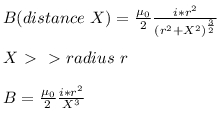
Put appropriate punctuation marks in the following sentences.Sorry to disturb you could I speak to you for a moment Correct answer is 'Sorry to disturb you – could I speak to you for a moment?'. Can you explain this answer?
Put appropriate punctuation marks in the following sentences.
Sorry to disturb you could I speak to you for a moment

|
Gowri Chakraborty answered |
In the sentence "Sorry to disturb you – could I speak to you for a moment?", the appropriate punctuation marks are a hyphen (-) after "disturb you" and a question mark (?) after "moment".
The hyphen is used to join two words together, in this case "disturb" and "you", to form a compound adjective. A compound adjective is an adjective made up of two or more words that describes a noun. In this sentence, the compound adjective "sorry to disturb you" describes the speaker and indicates that they feel apologetic about interrupting the person they are speaking to.
The question mark is used to indicate that the sentence is a question. In this case, the speaker is asking if they can speak to the person for a moment.
Overall, the punctuation in the sentence helps to clarify the meaning and structure of the sentence, making it easier for the reader to understand.
Magnetic Field inside a solenoid is ________.- a)increases from one end to another
- b)uniform
- c)varies from point to point
- d)None of the above
Correct answer is option 'B'. Can you explain this answer?
Magnetic Field inside a solenoid is ________.
a)
increases from one end to another
b)
uniform
c)
varies from point to point
d)
None of the above

|
Mohit Rajpoot answered |
Solenoid: A cylindrical coil of many tightly wound turns of insulated wire with a general diameter of the coil smaller than its length is called a solenoid.
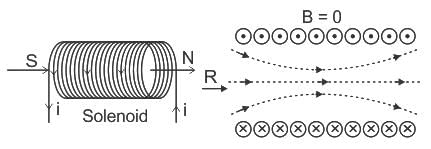
- A magnetic field is produced around and within the solenoid.
- The magnetic field within the solenoid is uniform and parallel to the axis of the solenoid.
The strength of the magnetic field in a solenoid is given by:-

Where, N = number of turns,
l = length of the solenoid,
l = current in the solenoid and
μo = absolute permeability of air or vacuum.
The magnetic field inside a solenoid is uniform. So option 2 is correct.
l = length of the solenoid,
l = current in the solenoid and
μo = absolute permeability of air or vacuum.
The magnetic field inside a solenoid is uniform. So option 2 is correct.
The correct plot of the magnitude of magnetic field  vs distance r from centre of the wire is, if the radius of wire is R
vs distance r from centre of the wire is, if the radius of wire is R- a)
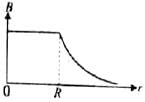
- b)
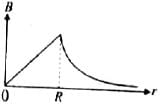
- c)
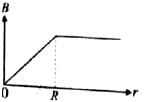
- d)
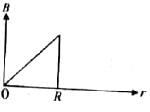
Correct answer is option 'B'. Can you explain this answer?
The correct plot of the magnitude of magnetic field  vs distance r from centre of the wire is, if the radius of wire is R
vs distance r from centre of the wire is, if the radius of wire is R
 vs distance r from centre of the wire is, if the radius of wire is R
vs distance r from centre of the wire is, if the radius of wire is Ra)

b)

c)

d)

|
|
Gaurav Kumar answered |
The magnetic field from the centre of wire of radius R is given by
B = ((μ0I)/(2R2))r (r < R) ⇒ B ∝ r
and B = μ0I/2πr (r > R) ⇒ B ∝ 1/r
From this descriptions, we can say that the graph (b) is a correct representation.
B = ((μ0I)/(2R2))r (r < R) ⇒ B ∝ r
and B = μ0I/2πr (r > R) ⇒ B ∝ 1/r
From this descriptions, we can say that the graph (b) is a correct representation.
Ampere's circuital law involves finding the _________.- a)total voltage enclosed by a closed path
- b)total current enclosed by a closed path
- c)total flux in a magnetic circuit
- d)total charge enclosed by a closed surface
Correct answer is option 'B'. Can you explain this answer?
Ampere's circuital law involves finding the _________.
a)
total voltage enclosed by a closed path
b)
total current enclosed by a closed path
c)
total flux in a magnetic circuit
d)
total charge enclosed by a closed surface

|
Lead Academy answered |
The correct answer is option b (total current enclosed by a closed path)
Ampere's Circuital Law:
- It gives the relationship between the current and the magnetic field created by it.
- This law says that the integral of magnetic field density (B) along an imaginary closed path is equal to the product of current enclosed by the path and permeability of the medium.
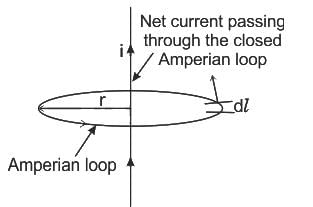

Where dl is a small element,
μ0 is the permeability of free space and
I is the electric current.
Two parallel conductors carrying current in opposite directions will exert on each other- a)an attractive forces
- b)a repulsive force
- c)an axial force
- d)no force
Correct answer is option 'B'. Can you explain this answer?
Two parallel conductors carrying current in opposite directions will exert on each other
a)
an attractive forces
b)
a repulsive force
c)
an axial force
d)
no force

|
Top Rankers answered |
This phenomenon is known as Ampere's force law or the parallel currents interaction. According to the right-hand rule, the magnetic fields produced by the currents in the two conductors will be in the same direction between the conductors and in the opposite direction outside the conductors.
Therefore, when two parallel conductors carry current in opposite directions, they will exert a repulsive force on each other.
Ampere's circuital law is given by- a)

- b)

- c)

- d)

Correct answer is option 'B'. Can you explain this answer?
Ampere's circuital law is given by
a)

b)

c)

d)

|
|
Riya Banerjee answered |
The line integral of the magnetic field of induction  around any closed path in free space is equal to absolute permeability of free space μ0 times the total current flowing through area bounded by the path.
around any closed path in free space is equal to absolute permeability of free space μ0 times the total current flowing through area bounded by the path.
Ampere's circuital law is given by:
 around any closed path in free space is equal to absolute permeability of free space μ0 times the total current flowing through area bounded by the path.
around any closed path in free space is equal to absolute permeability of free space μ0 times the total current flowing through area bounded by the path.Ampere's circuital law is given by:

Which of the following statement is correct regarding Ampere's circuital law?
I. The law can be applied inside a conductor or outside it but total current enclosed by the path should be known
II. The law is applicable for line currents, sheet currents or volume currents- a)Only II
- b)Neither I nor II
- c)Both I and II
- d)Only I
Correct answer is option 'C'. Can you explain this answer?
Which of the following statement is correct regarding Ampere's circuital law?
I. The law can be applied inside a conductor or outside it but total current enclosed by the path should be known
II. The law is applicable for line currents, sheet currents or volume currents
I. The law can be applied inside a conductor or outside it but total current enclosed by the path should be known
II. The law is applicable for line currents, sheet currents or volume currents
a)
Only II
b)
Neither I nor II
c)
Both I and II
d)
Only I

|
Bs Academy answered |
The correct answer is Both I and II.
- Ampere's Circuital Law states that the line integral of the magnetic field around any closed path is equal to the permeability of free space times the total current enclosed by the path.
- The law is mathematically expressed as ∮B·dl = μ₀Ienc, where ∮B·dl is the line integral of the magnetic field B around a closed loop, μ₀ is the permeability of free space, and Ienc is the total current enclosed by the loop.
- The law can be applied in various scenarios including inside a conductor or outside it, provided the total current enclosed by the path is known.
- This is crucial for determining the magnetic field in different regions around current-carrying conductors.
- Hence, statement I is correct.
- The law is applicable for different types of currents such as line currents, sheet currents, or volume currents.
- Line currents refer to currents flowing through thin wires or conductors.
- Sheet currents are currents distributed over a surface.
- Volume currents are currents distributed throughout a volume.
- The versatility of Ampere's Circuital Law in handling these different types of current distributions makes it a powerful tool in electromagnetism.
- Hence, statement II is correct.
Ampere's circuital law states that _______.- a)the line integral of h along any closed path is exactly opposite to the direct current enclosed by the path
- b)the line integral of h along any closed path is exactly opposite to the indirect current enclosed by the path
- c)the line integral of h along any closed path is exactly equal to the direct current enclosed by the path
- d)the line integral of h along any closed path is exactly equal to the indirect current enclosed by the path
Correct answer is option 'C'. Can you explain this answer?
Ampere's circuital law states that _______.
a)
the line integral of h along any closed path is exactly opposite to the direct current enclosed by the path
b)
the line integral of h along any closed path is exactly opposite to the indirect current enclosed by the path
c)
the line integral of h along any closed path is exactly equal to the direct current enclosed by the path
d)
the line integral of h along any closed path is exactly equal to the indirect current enclosed by the path

|
Top Rankers answered |
The correct answer is the line integral of h along any closed path is exactly equal to the direct current enclosed by the path.
- Ampere's Circuital Law: This fundamental law in electromagnetism states that the line integral of the magnetic field intensity (H) around a closed path is equal to the total current enclosed by that path.
- The law can be mathematically expressed as: ∮H · dl = Ienc, where ∮H · dl is the line integral of the magnetic field around the closed path, and Ienc is the enclosed current.
- This law is integral in understanding the relationship between the magnetic field and the electric current that produces it.
- It is particularly useful in the design and analysis of electrical circuits, transformers, inductors, and other electromagnetic devices.
Match the following mathematical representations with their corresponding law: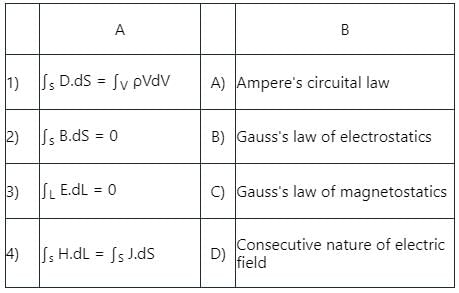
- a)1 - d, 2 - b, 3 - c, 4 - a
- b)1 - c, 2 - b, 3 - d, 4 - a
- c)1 - b, 2 - c, 3 - d, 4 - a
- d)1 - a, 2 - c, 3 - b, 4 - d
Correct answer is option 'C'. Can you explain this answer?
Match the following mathematical representations with their corresponding law:

a)
1 - d, 2 - b, 3 - c, 4 - a
b)
1 - c, 2 - b, 3 - d, 4 - a
c)
1 - b, 2 - c, 3 - d, 4 - a
d)
1 - a, 2 - c, 3 - b, 4 - d

|
EduRev NEET answered |
Mathematical representations with their corresponding law
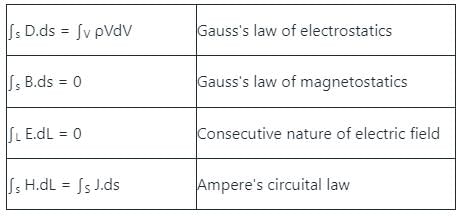
Ampere's Circuital Law:
- Ampere’s circuital law can be written as the line integral of the magnetic field (H) surrounding the closed loop equals the number of times the algebraic sum of currents passing through the loop. It can be expressed as
∫ Hdl = Ienc - Suppose a conductor carries a current I, then this current flow generates a magnetic field that surrounds the wire.
- The equation’s left side describes that if an imaginary path encircles the wire and the magnetic field is added at every point, then it is numerically equal to the current encircled by this route, indicated by Ienc.
- Equation of Ampere's circuital law further described as
- ∫s H.dL = ∫s J.ds (∵ Ienc = ∫s J.ds)
- Where J represents the current density
Gauss's law of Electrostatics:
- Gauss Law of electrostatics states that the total electric flux out of a closed surface is equal to the charge enclosed divided by the permittivity.
- In other words, according to the Gauss law, the total flux linked with a closed surface is 1/ε0 times the charge enclosed by the closed surface. It can be expressed as

- The electric flux in an area is defined as the electric field multiplied by the area of the surface projected in a plane and perpendicular to the field.
- Further equation of Gauss Law of electrostatics can be expressed as
- ∫s D.dS = ∫V ρVdV
- Where 'ρV' represents volume charge density and 'D' represents electric flux density vector.
Gauss's law of Magnetostatics:
- Gauss law on magnetostatics states that “closed surface integral of magnetic flux density (B) is always equal to total scalar magnetic flux enclosed (ϕenc) within that surface of any shape or size lying in any medium.”
- Mathematically it is expressed as
- ∫s B.ds = ϕenc
- But magnetic flux cannot be enclosed within a closed surface of any shape, therefore ϕenc = 0
- Hence, the equation of Gauss law on magnetostatics can be expressed as ∫s B.ds = 0
Conservative nature of the electric field:
- The electric field is defined as the electric force per unit charge.
- If we observe the electric field pattern, it is radially directed outward from a positive charge and is directed inwards a negative point charge.
- The electric field is a vector quantity, and the SI unit of the electric field is volts per meter.
- The electric field (E) is a conservative field and it is expressed as
- ∫ L E.dL = 0
- A force is said to be conservative if the work done by the force in moving a particle from one point to another point depends only on the initial and final points and not on the path followed.
- The field where the conservative force is observed is known as a conservative field.
- For Example, consider an electric field created due to a charge Q.
- The work done to carry a test charge (q) from point A to another point B in the field due to Q does not depend upon the path followed.
- Electric field depends upon the initial and final positions A and B. Electric fields are independent of the path followed.
- So we say that the electric field is conservative in nature.
- Consecutive nature of electric field
When a positively charged particle enters a uniform magnetic field with uniform velocity, its trajectory can be (i) a straight line (ii) a circle (iii) a helix.- a)(i) only
- b)(i) or (ii)
- c)(i) or (iii)
- d)any one of (i), (ii) and (iii)
Correct answer is option 'D'. Can you explain this answer?
When a positively charged particle enters a uniform magnetic field with uniform velocity, its trajectory can be (i) a straight line (ii) a circle (iii) a helix.
a)
(i) only
b)
(i) or (ii)
c)
(i) or (iii)
d)
any one of (i), (ii) and (iii)
|
|
Manoj Datta answered |
Explanation:
Introduction:
When a positively charged particle enters a uniform magnetic field with a uniform velocity, its trajectory can be a straight line, a circle, or a helix. The exact trajectory depends on the initial conditions of the particle, such as its velocity, charge, and angle of entry into the magnetic field.
Effect of Magnetic Field on Charged Particle:
When a charged particle moves through a magnetic field, it experiences a force called the magnetic Lorentz force. This force acts perpendicular to both the velocity of the particle and the magnetic field. The magnitude of the magnetic force can be given by the equation F = qvBsinθ, where F is the force, q is the charge of the particle, v is the velocity of the particle, B is the magnetic field strength, and θ is the angle between the velocity and the magnetic field.
Force Acting on a Particle:
The force acting on a positively charged particle in a magnetic field can be determined by the right-hand rule. If the thumb of the right hand points in the direction of the velocity of the particle, and the fingers point in the direction of the magnetic field, then the palm will point in the direction of the force acting on the particle.
Possible Trajectories:
The trajectory of a charged particle in a magnetic field depends on the initial conditions of the particle. The following are the possible trajectories:
1. Straight Line:
If the initial velocity of the particle is parallel or antiparallel to the magnetic field, then the force acting on the particle will be zero. In this case, the particle will continue to move in a straight line without any deflection.
2. Circle:
If the initial velocity of the particle is perpendicular to the magnetic field, the force acting on the particle will be maximum. This force will act as a centripetal force and cause the particle to move in a circular path with a constant radius.
3. Helix:
If the initial velocity of the particle has both a component perpendicular to the magnetic field and a component parallel to the magnetic field, the force acting on the particle will have both a radial and an axial component. This will cause the particle to move in a helical path.
Conclusion:
In conclusion, when a positively charged particle enters a uniform magnetic field with a uniform velocity, its trajectory can be a straight line, a circle, or a helix depending on the initial conditions of the particle. Therefore, the correct answer is option 'D' - any one of (i), (ii), and (iii).
Introduction:
When a positively charged particle enters a uniform magnetic field with a uniform velocity, its trajectory can be a straight line, a circle, or a helix. The exact trajectory depends on the initial conditions of the particle, such as its velocity, charge, and angle of entry into the magnetic field.
Effect of Magnetic Field on Charged Particle:
When a charged particle moves through a magnetic field, it experiences a force called the magnetic Lorentz force. This force acts perpendicular to both the velocity of the particle and the magnetic field. The magnitude of the magnetic force can be given by the equation F = qvBsinθ, where F is the force, q is the charge of the particle, v is the velocity of the particle, B is the magnetic field strength, and θ is the angle between the velocity and the magnetic field.
Force Acting on a Particle:
The force acting on a positively charged particle in a magnetic field can be determined by the right-hand rule. If the thumb of the right hand points in the direction of the velocity of the particle, and the fingers point in the direction of the magnetic field, then the palm will point in the direction of the force acting on the particle.
Possible Trajectories:
The trajectory of a charged particle in a magnetic field depends on the initial conditions of the particle. The following are the possible trajectories:
1. Straight Line:
If the initial velocity of the particle is parallel or antiparallel to the magnetic field, then the force acting on the particle will be zero. In this case, the particle will continue to move in a straight line without any deflection.
2. Circle:
If the initial velocity of the particle is perpendicular to the magnetic field, the force acting on the particle will be maximum. This force will act as a centripetal force and cause the particle to move in a circular path with a constant radius.
3. Helix:
If the initial velocity of the particle has both a component perpendicular to the magnetic field and a component parallel to the magnetic field, the force acting on the particle will have both a radial and an axial component. This will cause the particle to move in a helical path.
Conclusion:
In conclusion, when a positively charged particle enters a uniform magnetic field with a uniform velocity, its trajectory can be a straight line, a circle, or a helix depending on the initial conditions of the particle. Therefore, the correct answer is option 'D' - any one of (i), (ii), and (iii).
Chapter doubts & questions for MCQ Corner - NCERT on your Fingertips 2025-2026 Edition 2025 is part of NEET exam preparation. The chapters have been prepared according to the NEET exam syllabus. The Chapter doubts & questions, notes, tests & MCQs are made for NEET 2025 Exam. Find important definitions, questions, notes, meanings, examples, exercises, MCQs and online tests here.
Chapter doubts & questions of MCQ Corner - NCERT on your Fingertips 2025-2026 Edition in English & Hindi are available as part of NEET exam.
Download more important topics, notes, lectures and mock test series for NEET Exam by signing up for free.

Contact Support
Our team is online on weekdays between 10 AM - 7 PM
Typical reply within 3 hours
|
Free Exam Preparation
at your Fingertips!
Access Free Study Material - Test Series, Structured Courses, Free Videos & Study Notes and Prepare for Your Exam With Ease

 Join the 10M+ students on EduRev
Join the 10M+ students on EduRev
|

|
Create your account for free
OR
Forgot Password
OR
Signup to see your scores
go up
within 7 days!
within 7 days!
Takes less than 10 seconds to signup


